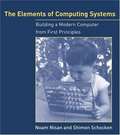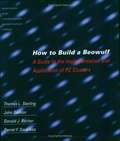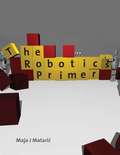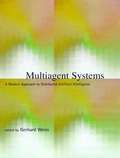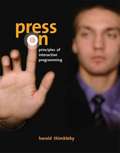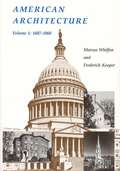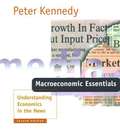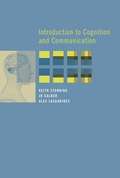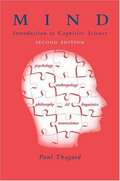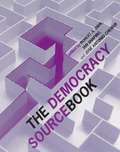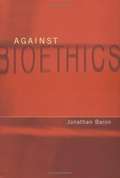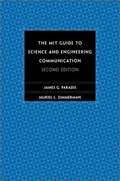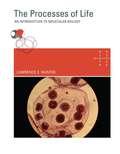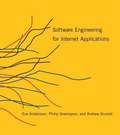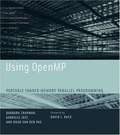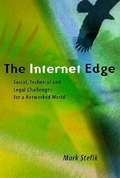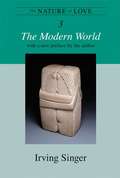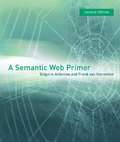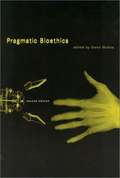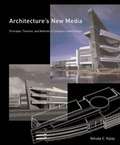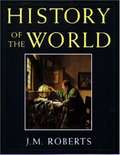- Table View
- List View
The Elements of Computing Systems: Building a Modern Computer from First Principles
by Noam Nisan Shimon SchockenIn the early days of computer science, the interactions of hardware, software, compilers, and operating system were simple enough to allow students to see an overall picture of how computers worked. With the increasing complexity of computer technology and the resulting specialization of knowledge, such clarity is often lost. Unlike other texts that cover only one aspect of the field, The Elements of Computing Systems gives students an integrated and rigorous picture of applied computer science, as its comes to play in the construction of a simple yet powerful computer system. Indeed, the best way to understand how computers work is to build one from scratch, and this textbook leads students through twelve chapters and projects that gradually build a basic hardware platform and a modern software hierarchy from the ground up. In the process, the students gain hands-on knowledge of hardware architecture, operating systems, programming languages, compilers, data structures, algorithms, and software engineering. Using this constructive approach, the book exposes a significant body of computer science knowledge and demonstrates how theoretical and applied techniques taught in other courses fit into the overall picture. Designed to support one- or two-semester courses, the book is based on an abstraction-implementation paradigm; each chapter presents a key hardware or software abstraction, a proposed implementation that makes it concrete, and an actual project. The emerging computer system can be built by following the chapters, although this is only one option, since the projects are self-contained and can be done or skipped in any order. All the computer science knowledge necessary for completing the projects is embedded in the book, the only pre-requisite being a programming experience. The book's web site provides all tools and materials necessary to build all the hardware and software systems described in the text, including two hundred test programs for the twelve projects. The projects and systems can be modified to meet various teaching needs, and all the supplied software is open-source.
How to Build a Beowulf: A Guide to the Implementation and Application of PC Clusters
by Thomas L. Sterling John Salmon Donald J. Becker Daniel F. SavareseSupercomputing research--the goal of which is to make computers that are ever faster and more powerful--has been at the cutting edge of computer technology since the early 1960s. Until recently, research cost in the millions of dollars, and many of the companies that originally made supercomputers are now out of business. The early supercomputers used distributed computing and parallel processing to link processors together in a single machine, often called a mainframe. Exploiting the same technology, researchers are now using off-the-shelf PCs to produce computers with supercomputer performance. It is now possible to make a supercomputer for less than $40,000. Given this new affordability, a number of universities and research laboratories are experimenting with installing such Beowulf-type systems in their facilities. This how-to guide provides step-by-step instructions for building a Beowulf-type computer, including the physical elements that make up a clustered PC computing system, the software required (most of which is freely available), and insights on how to organize the code to exploit parallelism. The book also includes a list of potential pitfalls.
The Robotics Primer
by Maja J. MatarićChoice Outstanding Academic Title, 2008. The Robotics Primer offers a broadly accessible introduction to robotics for students at pre-university and university levels, robot hobbyists, and anyone interested in this burgeoning field. The text takes the reader from the most basic concepts (including perception and movement) to the most novel and sophisticated applications and topics (humanoids, shape-shifting robots, space robotics), with an emphasis on what it takes to create autonomous intelligent robot behavior. The core concepts of robotics are carried through from fundamental definitions to more complex explanations, all presented in an engaging, conversational style that will appeal to readers of different backgrounds. The Robotics Primer covers such topics as the definition of robotics, the history of robotics ("Where do Robots Come From?"), robot components, locomotion, manipulation, sensors, control, control architectures, representation, behavior ("Making Your Robot Behave"), navigation, group robotics, learning, and the future of robotics (and its ethical implications). To encourage further engagement, experimentation, and course and lesson design, The Robotics Primer is accompanied by a free robot programming exercise workbook. The Robotics Primer is unique as a principled, pedagogical treatment of the topic that is accessible to a broad audience; the only prerequisites are curiosity and attention. It can be used effectively in an educational setting or more informally for self-instruction. The Robotics Primer is a springboard for readers of all backgrounds--including students taking robotics as an elective outside the major, graduate students preparing to specialize in robotics, and K-12 teachers who bring robotics into their classrooms.
Multiagent Systems: A Modern Approach to Distributed Artificial Intelligence
by Gerhard WeissThis is the first comprehensive introduction to multiagent systems and contemporary distributed artificial intelligence that is suitable as a textbook.
Economics of Regulation and Antitrust (4th edition)
by W. Kip Viscusi Joseph E. Harrington John M. VernonThis new edition of the leading text on business and government focuses on the insights economic reasoning can provide in analyzing regulatory and antitrust issues. Departing from the traditional emphasis on institutions, Economics of Regulation and Antitrust tasks how economic theory and empirical analysis can illuminate the character of market operation and the role for government action and brings new developments in theory and empirical methodology to bear on these questions. The fourth edition has been substantially revised and updated throughout, with new material added and extended discussion of many topics. Part I, on antitrust, has been given a major revision to reflect advances in economic theory and recent antitrust cases, including the case against Microsoft and the Supreme Court's Kodak decision. Part II, on economic regulation, updates its treatment of the restructuring and deregulation of the telecommunications and electric power industries, and includes an analysis of what went wrong in the California energy market in 2000 and 2001. Part III, on social regulation, now includes increased discussion of risk-risk analysis and extensive changes to its discussion of environmental regulation. The many case studies included provide students not only pertinent insights for today but also the economic tools to analyze the implications of regulations and antitrust policies in the future. The book is suitable for use in a wide range of courses in business, law, and public policy, for undergraduates as well at the graduate level. The structure of the book allows instructors to combine the chapters in various ways according to their needs. Presentation of more advanced material is self-contained. Each chapter concludes with questions and problems.
Press On: Principles of Interaction Programming
by Harold ThimblebyInteractive systems and devices, from mobile phones to office copiers, do not fulfill their potential for a wide variety of reasons--not all of them technical. Press On shows that we can design better interactive systems and devices if we draw on sound computer science principles. It uses state machines and graph theory as a powerful and insightful way to analyze and design better interfaces and examines specific designs and creative solutions to design problems. Programmers--who have the technical knowledge that designers and users often lack--can be more creative and more central to interaction design than we might think. Sound programming concepts improve device design. Press On provides the insights, concepts and programming tools to improve usability. Knowing the computer science is fundamental, but Press On also shows how essential it is to have the right approaches to manage the design of systems that people use. Particularly for complex systems, the social, psychological and ethical concerns--the wider design issues--are crucial, and these are covered in depth. Press On highlights key principles throughout the text and provides cross-topic linkages between chapters and suggestions for further reading. Additional material, including all the program code used in the book, is available on an interactive web site. Press On is an essential textbook and reference for computer science students, programmers, and anyone interested in the design of interactive technologies.
American Architecture: 1607-1860
by Marcus Whiffen Frederick KoeperThe first volume of a two-volume survey of American Architecture, this book covers architectural developments from Jamestown to the Civil War.
Macroeconomics Essentials: Understanding Economics in the News (Second Edition)
by Peter KennedyWhat do we want our students to be able to do upon completing an introductory course in macroeconomics--shift curves on diagrams or interpret media commentary on the economy? This book, an effort to lead students in the latter direction, offers a clear exposition of introductory macroeconomic theory along with more than 600 one- or two-sentence "news clips" that serve as illustrations and exercises. The author calls this approach "media economics" to distinguish it from the encyclopedic character of traditional texts. The book provides a guide to what the author calls the "really important" ideas of macroeconomics, with a strong connection to the real world. Thus many instructors will find the book suitable for use in courses enrolling business students. The method of presentation allows room for topics that are crucial for the interpretation of news commentary, but given inadequate coverage in traditional macroeconomics texts. Examples include the many roles of nominal versus real interest rates, and international phenomena such as purchasing power parity. Despite its nontechnical presentation, the material in the book is quite challenging for students; to answer questions based on the news clips, students must truly understand the economic concepts and apply problem-solving skills rather than rote learning. This text, unlike other economic texts, provides the student with a practical yet sophisticated grasp of the macroeconomic principles necessary to interpret media commentary. The second edition has been revised and updated throughout.
Introduction to Cognition and Communication
by Keith Stenning Alex Lascarides Jo CalderThis introduction to the interdisciplinary study of cognition takes the novel approach of bringing several disciplines to bear on the subject of communication. Using the perspectives of linguistics, logic, AI, philosophy, and psychology--the component fields of cognitive science--to explore topics in human communication in depth, the book shows readers and students from any background how these disciplines developed their distinctive views, and how those views interact. The book introduces some sample phenomena of human communication that illustrate the approach of cognitive science in understanding the mind, and then considers theoretical issues, including the relation of logic and computation and the concept of representation. It describes the development of a model of natural language and explores the link between an utterance and its meaning and how this can be described in a formal way on the basis of recent advances in AI research. It looks at communication employing graphical messages and the similarities and differences between language and diagrams. Finally, the book considers some general philosophical critiques of computational models of mind. The book can be used at a number of different levels. A glossary, suggestions for further reading, and a Web site with multiple-choice questions are provided for nonspecialist students; advanced students can supplement the material with readings that take the topics into greater depth.
Mind: Introduction to Cognitive Science (2nd edition)
by Paul ThagardCognitive science approaches the study of mind and intelligence from an interdisciplinary perspective, working at the intersection of philosophy, psychology, artificial intelligence, neuroscience, linguistics, and anthropology. With Mind, Paul Thagard offers an introduction to this interdisciplinary field for readers who come to the subject with very different backgrounds. It is suitable for classroom use by students with interests ranging from computer science and engineering to psychology and philosophy. Thagard's systematic descriptions and evaluations of the main theories of mental representation advanced by cognitive scientists allow students to see that there are many complementary approaches to the investigation of mind. The fundamental theoretical perspectives he describes include logic, rules, concepts, analogies, images, and connections (artificial neural networks). The discussion of these theories provides an integrated view of the different achievements of the various fields of cognitive science. This second edition includes substantial revision and new material. Part I, which presents the different theoretical approaches, has been updated in light of recent work the field. Part II, which treats extensions to cognitive science, has been thoroughly revised, with new chapters added on brains, emotions, and consciousness. Other additions include a list of relevant Web sites at the end of each chapter and a glossary at the end of the book. As in the first edition, each chapter concludes with a summary and suggestions for further reading.
The Democracy Sourcebook
by Robert Alan Dahl I. Shapiro José Antonio CheibubThe Democracy Sourcebook offers a collection of classic writings and contemporary scholarship on democracy, creating a book that can be used by undergraduate and graduate students in a wide variety of courses, including American politics.
Against Bioethics
by Jonathan BaronGovernments, health professionals, patients, research institutions, and research subjects look to bioethicists for guidance in making important decisions about medical treatment and research.
The MIT Guide to Science and Engineering Communication (Second Edition)
by James G. Paradis Muriel L. ZimmermanThis guide covers the basics of scientific and engineering communication, including defining an audience, working with collaborators, searching the literature, organizing and drafting documents, developing graphics, and documenting sources.
The Processes of Life: An Introduction to Molecular Biology
by Lawrence E. HunterRecent research in molecular biology has produced a remarkably detailed understanding of how living things operate.
Software Engineering for Internet Applications
by Eve Astrid Andersson Philip Greenspun Andrew GrumetAfter completing this self-contained course on server-based Internet applications software, students who start with only the knowledge of how to write and debug a computer program will have learned how to build web-based applications.
Paths to a Green World: The Political Economy of the Global Environment
by Jennifer Clapp Peter DauvergneThis comprehensive and accessible text fills the need for a political economy view of global environmental politics, focusing on the ways key economic processes affect environmental outcomes.
Using OpenMP: Portable Shared Memory Parallel Programming
by Barbara Chapman Gabriele Jost David J. Kuck Ruud Van Der PasThis book should provide an excellent introduction to beginners, and the performance section should help those with some experience who want to push OpenMP to its limits.
The Internet Edge: Social, Technical, and Legal Challenges for a Networked World
by Mark J. StefikThis book offers an eagle's eye view of the Internet edge. It is about the experiences of those who encountered similar issues as they built precursors to the Net such as videotext, teletext, and the Source.
The Nature Of Love: The Modern World
by Irving SingerIn the third volume, Singer examines the pervasive dialectic between optimistic idealism and pessimistic realism in modern thinking about the nature of love. He begins by discussing "anti-Romantic Romantics" (focusing on Kierkegaard, Nietzsche, and Tolstoy), influential nineteenth-century thinkers whose views illustrate much of the ambiguity and self-contradiction that permeate thinking about love in the last hundred years. He offers detailed studies of Freud, Proust, Shaw, D. H. Lawrence, and Santayana, and he maps the ideas about love in Continental existentialism, particularly those of Sartre and de Beauvoir. Singer finally envisages a future of cooperation between pluralistic humanists and empirical scientists. This last volume of Singer's trilogy does not pretend to offer the final word on the subject, any more than do most of the philosophers he discusses, but his masterful work can take its place beside their earlier investigations into these vast and complex questions. Irving Singer Library
A Semantic Web Primer
by Grigoris Antoniou Frank Van HarmelenThe development of the Semantic Web, with machine-readable content, has the potential to revolutionize the World Wide Web and its use. A Semantic Web Primer provides an introduction and guide to this still emerging field, describing its key ideas, languages, and technologies. Suitable for use as a textbook or for self-study by professionals, it concentrates on undergraduate-level fundamental concepts and techniques that will enable readers to proceed with building applications on their own and includes exercises, project descriptions, and annotated references to relevant online materials. A Semantic Web Primer provides a systematic treatment of the different languages (XML, RDF, OWL, and rules) and technologies (explicit metadata, ontologies, and logic and inference) that are central to Semantic Web development as well as such crucial related topics as ontology engineering and application scenarios. This substantially revised and updated second edition reflects recent developments in the field, covering new application areas and tools. The new material includes a discussion of such topics as SPARQL as the RDF query language; OWL DLP and its interesting practical and theoretical properties; the SWRL language (in the chapter on rules); OWL-S (on which the discussion of Web services is now based). The new final chapter considers the state of the art of the field today, captures ongoing discussions, and outlines the most challenging issues facing the Semantic Web in the future. Supplementary materials, including slides, online versions of many of the code fragments in the book, and links to further reading, can be found at www.semanticwebprimer.org.
Knowledge And Mind: A Philosophical Introduction
by Andrew Brook Robert J. StaintonThis is the only contemporary text to cover both epistemology and philosophy of the mind at an introductory level.
Pragmatic Bioethics (Second Edition)
by Glenn McgeeModern scientific and medical advances bring new complexity and urgency to ethical issues in health care and biomedical research. This book applies the American philosophical theory of pragmatism to such bioethics. Critics of pragmatism argue that it lacks a universal moral foundation. Yet it is this very lack of a metaphysical dividing line between facts and values that makes pragmatism such a rigorous and appropriate method for solving problems in bioethics. For pragmatism, ethics is a way of satisfying the complex demands of multiple individuals and groups in a contingent and changing world. Pragmatism also demands careful attention to the ways in which scientific advances change our values and ethics. The essays in this book present different approaches to pragmatism and different ways of applying pragmatism to scientific and medical matters. They use pragmatism to guide thinking about such timely topics as stem cell research, human cloning, genetic testing, human enhancement, and care for the poor and aging. This new edition contains three new chapters, on difficulties with applying pragmatism to law and bioethics, on helping people to die, and on embryonic stem cell research.
Water Resource Economics: The Analysis of Scarcity, Policies, and Projects
by Ronald C. GriffinEconomics brings powerful insights to water management, but most water professionals receive limited training in it. This text offers a comprehensive development of water resource economics that is accessible to engineers and natural scientists as well as economists. The goal is to build a practical platform for understanding and performing economic analysis using both theoretical and empirical tools. The mathematics needed to understand the subjects covered in this text include basic optimization methods and integral calculus. Familiarity with microeconomics or natural resource economics is helpful, but all the economics needed is presented and developed progressively in the text. Many water-based example calculations are included. Thus the book can be used for independent study as well as course work. The book focuses on the scarcity of water quantity (rather than water quality). The author presents the economic theory of resource allocation, recognizing the peculiarities imposed by water, and expands the theory to encompass time-defined matters such as ground water depletion. He then discusses such subjects as institutional economics, water law, how economics is used in policy and cost-benefit analysis, the roles of water marketing and water pricing, demand and supply estimation, privatization, and modeling with demand and supply functions. As an aid to readers with specific interests, references to recent literature are given for all of these topics. Each chapter ends with a summary and exercises. All graphic portrayals of economic theory and most calculations are performed using Mathematica software. These programs are downloadable, but their use is entirely optional.
Architecture's New Media: Principles, Theories, and Methods of Computer-Aided Design
by Yehuda E. KalayA comprehensive examination of computer-aided architectural design and its potential effect on architectural design practice, for practitioners, educators, students, and researchers.
A History of the World
by J. M. RobertsFrom the evolution of Homo Sapiens to the exploration of space, the vast landscape of human history appears in this authoritative, readable book. Evocatively illustrated, this work offers an outstanding one-volume survey of the major events, developments, and personalities of the known past. Illus. Maps.
